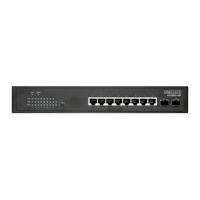Chapter 30
| Multicast Routing Commands
PIM Multicast Routing
– 1064 –
Example
The following example configures the router to start advertising itself to the BSR as
a candidate RP for the indicated multicast groups.
Console(config)#ipv6 pim rp-candidate interface vlan 1 group-prefix
FFAA::0101/8
Console(config)#end
Console#show ipv6 pim rp mapping
PIM Group-to-RP Mappings
Groups : FF00::/8
RP address : 2001:DB8:2222:7272::72/128
Info source : 2001:DB8:2222:7272::72/128, via bootstrap, priority: 0
Uptime : 00:02:35
Expire : 00:01:55
Console#
ipv6 pim
spt-threshold
This command prevents the last-hop PIM router from switching to Shortest Path
Source Tree (SPT) mode. Use the no form to allow the router to switch over to SPT
mode.
Syntax
ipv6 pim spt-threshold infinity [group-prefix group-prefix]
no ipv6 pim spt-threshold infinity
group-prefix - An IPv6 network prefix for a multicast group. If a group
address is not specified, the command applies to all multicast groups.
(Range: FFXX:X:X:X::X/<8-128>)
Default Setting
The last-hop PIM6 router joins the shortest path tree immediately after the first
packet arrives from a new source.
Command Mode
Global Configuration
Command Usage
◆ The default path for packets from a multicast source to a receiver is through the
RP. However, the path through the RP is not always the shortest path. Therefore,
the router uses the RP to forward only the first packet from a new multicast
group to its receivers. Afterwards, it calculates the shortest path tree (SPT)
directly between the receiver and source, and then uses the SPT to send all
subsequent packets from the source to the receiver instead of using the shared
tree. Note that when the SPT threshold is not set by this command, the PIM leaf
router will join the shortest path tree immediately after receiving the first
packet from a new source.
◆ This command forces the router to use the shared tree for all multicast groups,
or just for the specified multicast groups.

